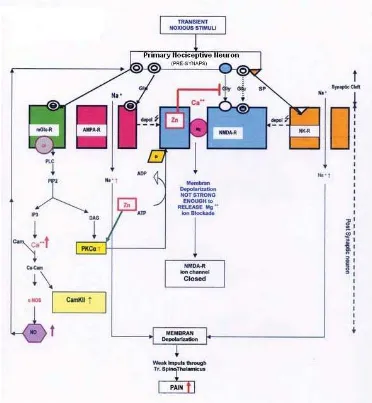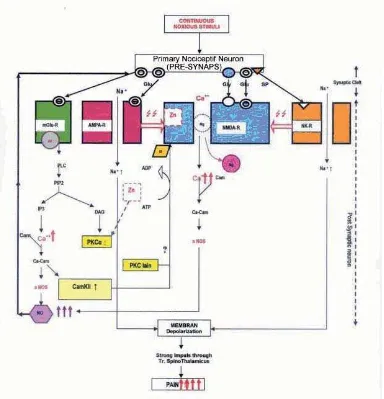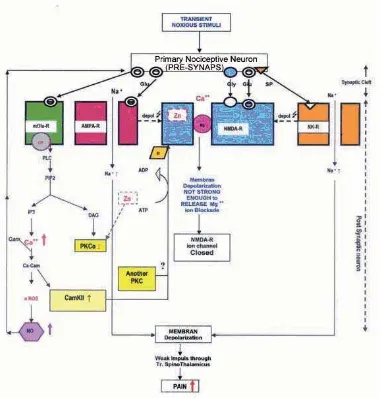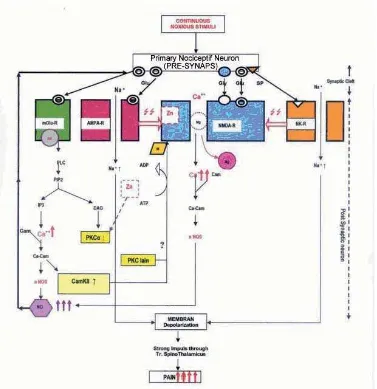The in
fl
uence of zinc de
fi
ciency on chronic pain in Sprague Dawley rats
Hari Bagianto
Medical Faculty Brawijaya University, Malang, Indonesia.
Abstrak
Tujuan Defi siensi Zinc (Zn) merupakan masalah pada sebagian besar negara-negara berkembang termasuk Indonesia, khususnya di kepulauan Nusa Tenggara Timur (NTT). Zn memegang peranan penting dalam proses nyeri melalui proses modulasi pada reseptor N-methyl-D-aspartate (NMDA), yang juga melibatkan neuronal nitric oxide synthase (nNOS) sebagai parameter nyeri. Penelitian ini dilakukan untuk mengetahui peranan Zn terhadap respons nyeri dan terhadap modulasi nyeri pada tingkat medulla spinalis pada tikus.
Metode Dua puluh tikus Sparague Dawley (SD) dibagi menjadi dua grup, yaitu grup normal dan grup defi sien (grup defi sien diberi makanan diet IRI-OB). Lebih lanjut tiap grup dibagi lagi menjadi dua subgrup, yaitu subgrup nyeri akut (stimulasi nyeri sesaat), dan subgrup nyeri kronik (stimulasi nyeri kontinu). Subgrup nyeri kronik dilakukan dengan cara operasi CCI Bennet pada tikus dalam grup ini. Ambang nyeri pada grup defi sien dan grup normal diukur secara klinis menggunakan tes plantar modifi kasi Ugo Basille (thermal transient noxious stimuli). Pengukuran nyeri kronik dilakukan dengan mengukur kadar nNOS secara imuno-histo-kimia.
Hasil Kelompok defi sien menunjukkan penurunan ambang nyeri yang tidak signifi kan (P= 0,251). Akan tetapi, terdapat peningkatan signifi kan nNOS (P= 0,027), terutama pada grup defi siensi dengan stimulasi nyeri kontinu.
Kesimpulan Hasil penelitian ini menunjukkan bahwa defi siensi Zn meningkatkan respons nyeri, khususnya pada nyeri kronis. (Med J Indones 2010; 19:88-95)
Abstract
Aim Zinc (Zn) defi ciency remains a problem in most developing countries, including Indonesia, especially in the East Nusa Tenggara (NTT) Islands. Zinc plays a major role in pain through the modulation process by the N-methyl-D-aspartate (NMDA) receptors, which also includes neuronal nitric oxide synthase (nNOS) as a pain parameter. The purpose of this study is to reveal the effects of Zn towards pain response and modulation stage at the spinal cord level in rats.
Methods Twenty Sprague Dawley (SD) rats were divided into two groups, a defi cient group and a normal group. The defi cient group was fed on an IRI-OB diet. Every group was further divided into two more groups, the acute pain group (transient noxious stimuli), and the chronic pain group (continuous noxious stimuli). The rats in chronic pain group were subjected to CCI Bennet operation. The pain thresholds in the defi cient group and normal group were measured clinically using a modifi ed Ugo Basille plantar test (thermal transient noxious stimuli). Measurement of chronic pain level was carried out by measuring the nNOS level by immunohistochemistry.
Results Defi cient group showed an insignifi cant decrease in pain threshold (P= 0.251). However, there is a signifi cant increase in nNOS (P= 0.027) especially in the defi cient group with continuous noxious stimulation.
Conclusions These results suggest that Zn defi ciency increases pain response, especially in chronic pain. (Med J Indones 2010; 19:88-95)
Key words: continuous noxious stimuli, nNOS, plantar test, transient noxious stimuli
Correspondence email to: bagianto@yahoo.com
In developing country including Indonesia, especially Nusa Tenggara Timur (NTT) islands, micronutrient defi ciency including zinc (Zn) defi ciency is still a crucial problem. Another study in Central Java also showed that the prevalence of serum zinc defi ciency was 70-90%. A small-scale study (1997-1999) in West Java, Central Java and Lombok showed that the prevalence of zinc defi ciency among infants was from 6 to 39%.1,2 Zinc is an
essential element for growing and developing process, because it is considered an essential component for over 200 kinds of metaloenzymes with various syntethic
The process of nociceptive pain consists of 4 stages, which are transduction, transmission, modulation and perception. Studies on the transduction and transmission stages have been done a lot, and most of them are established. The perception level is the most complex level, where many factors are involved. Therefore this study was focused on the modulation stage at the spinal cord level. Pain modulation is determined by the balance of inhibitory and excitatory receptors.
The NMDA receptors play an important role on the chronic pain modulation process.4 Zinc slows down the
NMDA receptor activities through inhibition of glycine receptor binding.5 The decrease of Zinc atom however
will make glycine-NMDA receptor binding easier and increase NMDA receptors excitability. This will increase the calcium ion intake through ion channel related NMDA receptors, which will later activate nNOS and ends up with the increase of Nitric-Oxide (NO) in the cytosol. Nitric-Oxide as a gas will immediately spread to presynaptic neuron cells and stimulates glutamate production, which will increase the stimulus on NMDA receptor and causes hyperalgesia. Eventhough at transient noxious stimulus NMDA receptors can not open the ion channel, NMDA receptor can still produce cytosol Ca2+ ions and NO through this way.
Based on the studies above, Zn atoms can reduce the pain response (inhibitory) through inhibition at glycine as NMDA receptor’s coagonist, but also increase pain response (excitatory) through protein kinase C-α (PKC-α) activation, which will phosphorilate NMDA receptors. The fact is, on normal Zn level, chronic pain can still occur. It means that the NMDA receptors can still be active even at normal Zn condition.
The purpose of this study was to reveal the effects of Zn towards pain response and modulation stage at the spinal cord level. We evaluated the effects of Zn toward pain response by measuring experimental animal responses to transient and continous noxious stimuli. Modulation stage at the spinal cord level was evaluated by measuring nNOS level in transient and continous noxious stimuli.
METHODS
Twenty male Sprague Dawley (SD) rats weighing 350-400g were divided into defi cient and normal groups. The defi cient group was fed on IRI-OB diet for 2 months. The IRI-OB diet is a diet devoid of Zn, according to
van Wouwe, J.P. et al 1986.11 This treatment creates
chronic Zn defi ciency.
Furthermore, each group was divided into 2 more groups, chronic pain group (continuous noxious stimuli) and acute pain group (transient noxious stimuli). The chronic pain group was engineered by chronic constriction injury (CCI) that was done by Bennet operation, in which the rats wereanesthetized using Nembutal (50mg/kg bodyweight), and the common sciatic nerve of the left hind paw was exposedat the level of the middle of the thigh by blunt dissection through the biceps femoris. Proximal to the sciatic trifurcation,approximately 7 mm of nerve was freed, and 4 loose ligaturesof 4–0 chromic gut were placed around the sciatic nerve for 3-7 days.13
Zn status was checked at tibial bone, because it has the most stable level than any other organs (hair, plasma, muscle etc.). Tibial bone was measured in weight, and reduced to ashes by 800oC
fl aming for 2 hours. Ashes of the bone were diluted in water and the level of Zn were evaluated with Shimatsu AA 6200 atomic absorption spectrophotometry (AAS) with ELISA technique.11
Pain examination was done clinically on defi cient and normal groups with plantar test equipment (modifi ed Ugo Basille). Plantar test is a transient noxious thermal stimulation; therefore acute pain threshold is being measured. In the chronic pain group, the rats got continuous noxious stimulation. Therefore, pain measurement using plantar test equipment is no longer valid. Pain measurements on chronic group (continuous noxious stimulation) and acute group (transient noxious stimulation) were done by measuring nNOS expression using immunohistochemistry method.
Immunohistochemistry method to reveal the nNOS expression was started with the preparation of slides of rats spinal cords. Principally the slides were blocked with H2O2 and NGS (normal goat serum); washed with phosphate buffered saline (PBS) pH 7.4, incubated in primary (anti-rat nNOS) antibody and then imunoperoxidase linked secondary antibody and fi nally visualized using DAB substrate.The end results were evaluated microscopically.12
RESULTS
Mean body weight for normal and defi cient group
Levene equality test showed no signifi cant difference between the two groups (P= 0.164). Further, the weight of rats in normal compared to the defi cient group showed no signifi cant difference (P= 0.761). These results proved the homogenity of the two groups. (Table 1)
Mean Zn level in normal and defi cient group
Levene equality test showed a signifi cant difference between the two groups (P= 0.007). Further, the Zn level for rats fed on normal Zn diet compared to the Zn restriction diet showed a signifi cant difference (P= 0.001). The Zn level in normal groups were higher. This results proved that the low Zn diet treatment was able to create a Zn defi ciency condition (Table 2).
Mean plantar test for normal and defi cient group
Even though Levene equality test showed a signifi cant difference between the two groups (P= 0.003), the plantar test on the defi cient group was not signifi cantly different from the normal group (P= 0.251). The defi cient group showed less value than normal group even though the difference was not signifi cant. This result proved that the low Zn diet was not able to decrease the threshold of transient noxious stimulation signifi cantly (Table 3).
F test for nNOS of all groups
F test (ANOVA) for nNOS in the four groups (continuous noxious stimuli on normal group, continuous noxious stimuli on defi cient group, transient noxious stimuli on normal group, and transient noxious stimuli on normal group) showed a signifi cant difference (P= 0.001). The nNOS overall value was higher on the defi cient groups and the continuous noxious stimuli. The highest value of nNOS was found in continuous noxious stimuli on defi cient group. The lowest value of nNOS was found in transient noxious stimuli on normal group (Table 4).
The Tukey test showed that the nNOS value in normal group with acute pain compared to defi cient group with acute pain showed no signifi cant difference, the same as the result of chronic compared to acute pain in normal group. The defi cient group with chronic pain showed the highest nNOS value that was different signifi cantly compared to other groups (Table 5).
In general, this study showed that in the defi cient groups, there was an insignifi cant decrease in plantar test result from 32.2 ± 2.2 seconds to 29.1 ± 7.9 seconds (P= 0.251). This fact means that Zn defi ciency doesn’t affect acute pain, because plantar test measure the pain threshold. However, a signifi cant increase occured in nNOS (P= 0.001) especially in the normal and defi cient group with chronic pain, which was 11.6 ± 1.5 cell/VF to 16.8 ± 3.3 cell/VF (P= 0.027). On the other hand, acute pain caused insignifi cant increase in nNOS, from 4.4 ± 1.5 cell/VF to 9.0 ± 3.4 cell/VF (P= 0.055). On the normal group, chronic compared to acute pain still produced a signifi cant increase in nNOS from 4.4 ± 1.5
Table 1. Mean body weight of normal and defi cient group
Group N Zn level (μg/L)
Mean ± SD Difference Normal 10 2679.2 ± 254.1
P= 0.001 Defi cient 10 516.1 ± 40.7
Table 2. Mean Zn level for normal and defi cient group
Group N Plantar test (seconds)
Mean ± SD Difference Normal 10 32.2 ± 2.2
P= 0.251 Defi cient 10 29.1 ± 7.9
Table 3. Mean plantar test for normal and defi cient group
Table 4. F test for nNOS of all groups
Groups Mean ± SD N
Continuous noxious stimuli on normal group 11.6 ± 1.5 5 Transient noxious stimuli on normal group 4.4 ± 1.5 5 Continuous noxious stimuli on defi cient group 16.8 ± 3.3 5 Transient noxious stimuli on defi cient group 9.0 ± 3.4 5
Table 5. Tukey test among dependent variable: nNOS Group nNOS (cell/visual fi eld, mean ± SD)
N Transient Noxious N Continuous Noxious Difference
Normal 5 4.4 ± 1.5 5 11,6 ± 1,5
DISCUSSION
The NMDA receptor plays an important role in chronic pain.4 Zinc inhibits the NMDA receptor through the
blockade of this receptor binding with glycine.5 The
NMDA receptor is a ligand and voltage dependent receptor. There are four mechanisms to activate NMDA receptor,6 i.e. glutamate binding as ligand, glycine binding
as co-agonist, the release of Mg+ blockade by strong enough membrane depolarization that is caused by strong and repetitive stimuli, and PKC α phosphorilation
The presynaptic neurons release three kinds of neurotransmitters in the transduction of noxious
stimuli, i.e. substance P (SP), glutamate and glycine. The main receptors in post synaptic neurons are SP receptor neurokinin receptor (NK-R), alfa-amino 3-hydroxy 5-methyl 4-isoxazolepropionic acid receptor (AMPA-R), NMDA receptor (NMDA-R), and metabotropic glutamate receptor (mGlu-R). The last three receptors are ionotropics.7
In normal Zn level, transient noxious stimuli impulse that fl ows through AMPA-R and Neurokinin-1 (NKR-1) depolarizes, but is not strong enough to cast aside the Mg2+
blockade by the ionic valve that is bound to NMDA-R, so the NMDA-R remains inactive (Figure 1).
Transient noxious stimuli on mGlu-R will turn PIP2 into inositol triphosphate (IP3) and diacyl glycerol (DAG) that would activate the PKC-α and produce nitric oxide (NO) out of nNOS.8 Protein kinase C-α
will activate NMDA-R through phosphorilation. To activate one molecule of cytosol PKC-α, 4 Zn atoms are required.9 Therefore, PKC-α activities are assumed
to decrease at Zn defi ciency, and so are NMDA-R activities. Inositol triphosphate that is produced by mGlu-R will stimulate Ca2+ ions out of endoplasmic
reticulum, which is an intracellular Ca ion deposit. This Ca2+ ion binds to calmudolin and will activate nNOS,
which will increase cytosol NO. Nitric-oxide as a gas will immediately spread to presynaptic neuron cell and stimulates glutamate production that will increase the stimulus on NMDA-R and creates hyperalgesia.
Due to strong or continuous noxious stimuli, the impulse of noxious stimuli in the AMPA-R becomes strong enough to release the Mg2+ ion blockade in the Ca2+
valve that is bound to NMDA-R, allowing the entrance of sodium and calcium ion and the exit of potassium ion through the ionic valve (Figure 2).
The NMDA-R has to bind glycine to be able to receive the impulse of glutamate neurotransmitter, while the binding was inhibited by Zn. Thus the NMDA-R does not work optimally, and could not produce suffi cient NO that is required to cause chronic pain.
cast aside the Mg2+ blockade in the ionic valve that is bound to NMDA-R, so the NMDA-R remains inactive, and the cytosol Ca2+ does not increase, thus does not
activate nNOS to produce NO and chronic pain.
The activation of mGlu-R will activate PKC through PIP2 pathway where DAG activates PKC-α. The PKC-α will activate NMDA-R through phosphorilation. To activate one molecule of cytosol PKC-α, 4 Zn atoms are required.9 Therefore, PKC-α activities are assumed
to decrease at Zn defi ciency state, and so are NMDA-R activities, and results in reduced pain.
Nevertheless, there’s a possibility that NMDA-R is phosphorilized by other protein kinase, such as Ca-calmodulin dependent protein kinase II (CaMKII) that is produced by mGlu-R. Phosphorilation of AMPA-R by CaMKII and PKC-α can be seen either in vitro or in vivo.10 If the same condition happens in NMDA-R, Zn
defi ciency will not affect phosphorilation of NMDA-R (Figure 4). Figure 4 explains that Zn defi ciency might increase the activity of NMDA-R even though there’s a decrease in the activity of PKC-α enzyme.
Our result proved that the low Zn diet treatment was not able to decrease the threshold of transient noxious stimulation. This result is similar to the clinical phenomenon in NTT in which there were no differences in labiopalatoschizis reconstruction postoperative pain between NTT island population group (which is assumed as a Zn defi ciency group) and Java island population group (which is assumed as the group with normal Zn level). In chronic stimuli group, the plantar test was not performed, because rats plantars in this group suffered from drop foot.
Our result showed that there was no signifi cant difference in bodyweight between Zn defi cient and normal group. This fact can be caused by adaptation process in diet, which was given for 7 weeks. Zn defi ciency will increase nNOS, while continous noxious stimuli will increase
nNOS in higher level. We found that the highest nNOS was produced by continous noxious stimuli in Zn defi cient group (P= 0.001). Tukey test showed that there was a signifi cant higher nNOS value in chronic pain and Zn defi cient group. The reason for this result is that in Zn defi cient group, glycine easily binds to NMDA-R, and facilitate glutamate as the ligand to bind to NMDA-R.
NMDA-R through phosphorilation. The IP3 will move closely to endoplasmic reticulum as intracellular Ca ion deposit. Endoplasmic reticulum will release Ca ion to cytosol to bind calmodulin and initiate NO formation by nNOS, or produce CaMKII that is infl uenced by Zn ion. We suggested that this kinase replaced PKC-α to phosphorilate NMDA-R. Continous noxious stimuli will give adequate stimuli to initiate strong depolarization to open calcium channel. Therefore, calcium ion will enter cytosol, binds calmodulin and activate more nNOS to produce NO.
In general, our result showed that on the Zn defi cient groups, there was an insignifi cant decrease in plantar test. The fact means that Zn defi ciency doesn’t affect acute pain because plantar test measures the pain threshold. However, a signifi cant increase occur in nNOS (P= 0.001) especially in the defi cient group with chronic pain. On the defi cient group with acute pain an unsignifi cant increase of nNOS occured. On the normal group, continuous noxious stimuli compared with transient noxious stimuli still produce a signifi cant increase of nNOS. Calcium ion plays a role in NO and CaMKII formation through mGlu-R that activates PKC enzyme.
In conclusion, Zn defi ciency increased pain response, especially in chronic pain. On rats with normal Zn, activation of the NMDA receptor might still occur, which was due to phosphorilation by PKC other than the Zn-dependent PKC-α.
REFERENCES
Atmarita. Nutrition problems in Indonesia. Integrated 1.
International seminar and workshop on lifestyle–related
diseases. 2005. March 19 – 20; Yogyakarta, Indonesia. Yogyakarta: Directorate of Community Nutrition, The Ministry of Health of Indonesia; 2005.
Prasad AS. Zn defi ciency. BMJ. 2003;326:409–10 2.
Mungiu QC, Ionescu DG, Jaba IM. Zn and nociception: 3.
a pharmacological approach. Rev Med Nat lasi. 2002; 106(1):10-3.
Petrenko AB, Yamakura T, Baba H, Shimoji K. Pain medicine. 4.
The role of N-Methyl-D-Aspartate (NMDA) receptors in pain: a review. Anesth Analg. 2003; 97:1108-16.
Suwa H, Amant LS, Triller A, Drapeau L, Pasca L. High-5.
affinity Zinc potentiation of inhibitory postsynaptic glycinergic currents in the Zebrafi sh hindbrain. J Neuro Physiol. 2001;85 (2): 912-25.
Mello RD, Dickenson AH. Spinal cord mechanisms of pain. 6.
Br J Anesth. 2008; 101(1):8-16.
Conn PJ, Niswender CM. Review: Metabotropic glutamate 7.
receptors: physiology, pharmacology, and disease. Annu Rev Pharmacol Toxico. 2010; 50:295-322.
Newton, Alexandra C. Protein kinase C: structural and 8.
spatial regulation by phosphorylation, cofactors, and macromolecular interactions in protein phosphorylation. Chem Rev. 2001; 101, 2353-64.
AF Quest, Bloomenthal J, Bardes ES, Bell RM. The 9.
regulatory domain of protein kinase C coordinates four atoms of Zinc. J Biol Chem. 1992; 267(14). 101193-7 Revest P, Longstaff A. Metabotropic receptors and signal 10.
transduction mechanism. In: Clarke AJ. editor Molecular Neuroscience. Oxford; Garland Science:1998. pp.72-86 Van Wouwe JP, Veldhuizen M, Goiej JJ, Hamer CJ. 11.
Laboratory assesment of early dietary, subclinical zinc defi ciency: a model study on weaning rats. Pediatr Res. 1991:391-5.
Soini Y, Paakko P, Lehto VP. Histopathological Evaluation 12.
of Apoptosis in Cancer. AmJ Pathol. 1998: 153: 1041-53. Kris V, Hugo A, Roland DC, Cathy DD, Theo FM. A chronic-13.




